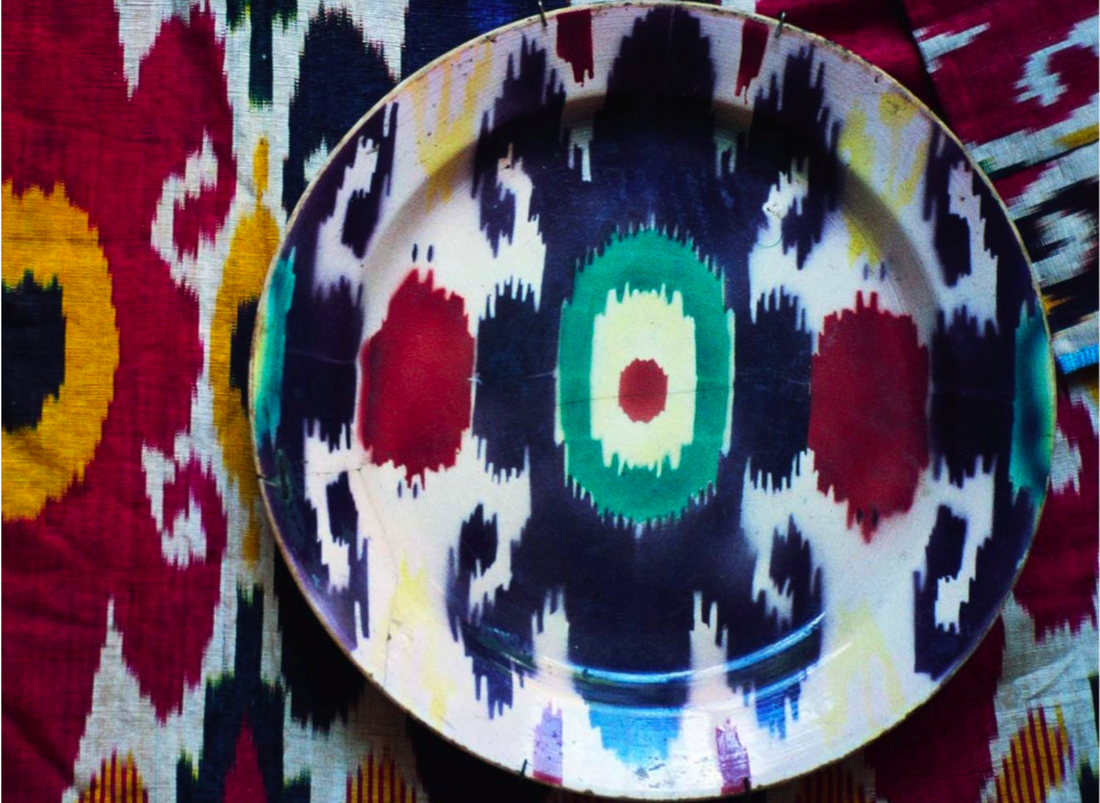
Cultureisserved: Ikat patterned plates
Guest edited by Victoria Z. Rivers
Culture is Served: Ikat patterned plates was first published in Selvedge issue 14: Imperial.
Most “textilians” would recognisea Central Asian ikat fabric but even the most ardent might be excused if they failed to spot these colourful, blurred-edged motifs on a plate or a bowl. Until recently there were few of these objects to spot. During the 1970s and 80s, world travellers may have glimpsed a fabric-like patterned plate in an Afghan or Uzbekistan bazaar, but it was only after the collapse of Soviet Russia in 1991 that these still rare ikat patterned plates began to appear in global textiles and artifact markets. The air-brushed designs of these plates have a contemporary feel that belies their age. The plates' backstamps consist of Cyrillic lettering with either a Czarist or Hapsburg double- headed eagle or crown and starburst motif, and reveal that most of these plates were manufactured in Russia between 1892 to 1917 – although there is still conflict about the exact dates. Most of the producing factories' records were burned for fuel during the Russian Revolution or destroyed in WWII.
Ikat plate production probably ceased around 1914 when supplies dried up and the political climate changed. The oldest ikat plate designs originated with the famous Gardner porcelain factory. Established in the 1770s, the factory had kiln and glazing technology to rival imported Meissen goods and satisfy the Russian aristocracy’s craving for ornate porcelains. The old Gardner factory drew widely for inspiration in its designs, including Russian folk idioms and textile motifs. In 1810, the Kuznetsov Brothers factory was founded. In 1889 it was renamed the M.S. Kuznetsov Factory, and became a conglomerate of seven factories producing Russian ceramics, including, following its purchase of the Gardner factory, the ikat plates. In the last days of the Gardner factory and the heyday of the Kuznetsov factories, both sought to manufacture goods that appealed to a broader audience and increasingly looked to indigenous designs of ethnic "others" for inspiration.

The M.S. Kuznetsov factories targeted the Asian markets of Iran, Turkey and Central Asia. While mold-poured platters and plates were the most commonly produced ikat-patterned ware, ikat serving pieces such as teapots and bowls were also manufactured but these are extremely rare. In Central Asia ikat fabrics had an aesthetic appeal and social function, conveying hierarchy and economic value. With their culturally familiar designs demand for the plates' was high. Many of the ikat motifs used in the plates, a double rams' horns motif; concentric or rhomboidal shaped eye-spots; parallel stripe variations; and dark scorpion/arachnid-like forms are preIslamic in origin, descended from Uzbek, Turkic tribal groups and evoke old beliefs in the magic or protective qualities of designs.
Culture is Served: Ikat patterned plates was first published in Selvedge issue 14: Imperial.
Most “textilians” would recognisea Central Asian ikat fabric but even the most ardent might be excused if they failed to spot these colourful, blurred-edged motifs on a plate or a bowl. Until recently there were few of these objects to spot. During the 1970s and 80s, world travellers may have glimpsed a fabric-like patterned plate in an Afghan or Uzbekistan bazaar, but it was only after the collapse of Soviet Russia in 1991 that these still rare ikat patterned plates began to appear in global textiles and artifact markets. The air-brushed designs of these plates have a contemporary feel that belies their age. The plates' backstamps consist of Cyrillic lettering with either a Czarist or Hapsburg double- headed eagle or crown and starburst motif, and reveal that most of these plates were manufactured in Russia between 1892 to 1917 – although there is still conflict about the exact dates. Most of the producing factories' records were burned for fuel during the Russian Revolution or destroyed in WWII.
Ikat plate production probably ceased around 1914 when supplies dried up and the political climate changed. The oldest ikat plate designs originated with the famous Gardner porcelain factory. Established in the 1770s, the factory had kiln and glazing technology to rival imported Meissen goods and satisfy the Russian aristocracy’s craving for ornate porcelains. The old Gardner factory drew widely for inspiration in its designs, including Russian folk idioms and textile motifs. In 1810, the Kuznetsov Brothers factory was founded. In 1889 it was renamed the M.S. Kuznetsov Factory, and became a conglomerate of seven factories producing Russian ceramics, including, following its purchase of the Gardner factory, the ikat plates. In the last days of the Gardner factory and the heyday of the Kuznetsov factories, both sought to manufacture goods that appealed to a broader audience and increasingly looked to indigenous designs of ethnic "others" for inspiration.

The M.S. Kuznetsov factories targeted the Asian markets of Iran, Turkey and Central Asia. While mold-poured platters and plates were the most commonly produced ikat-patterned ware, ikat serving pieces such as teapots and bowls were also manufactured but these are extremely rare. In Central Asia ikat fabrics had an aesthetic appeal and social function, conveying hierarchy and economic value. With their culturally familiar designs demand for the plates' was high. Many of the ikat motifs used in the plates, a double rams' horns motif; concentric or rhomboidal shaped eye-spots; parallel stripe variations; and dark scorpion/arachnid-like forms are preIslamic in origin, descended from Uzbek, Turkic tribal groups and evoke old beliefs in the magic or protective qualities of designs.
Want to read more of this article?
We are proud to be a subscriber-funded publication with members in 185 countries. We know our readership is passionate about textiles, so we invite you to help us preserve and promote the stories, memories, and histories that fabric holds. Your support allows us to publish our magazine, and also ‘what's on’ information, and subscription interviews, reviews, and long-read articles in our online blog.
ALREADY A SUBSCRIBER? CLICK HERE TO ACCESS CONTENT

